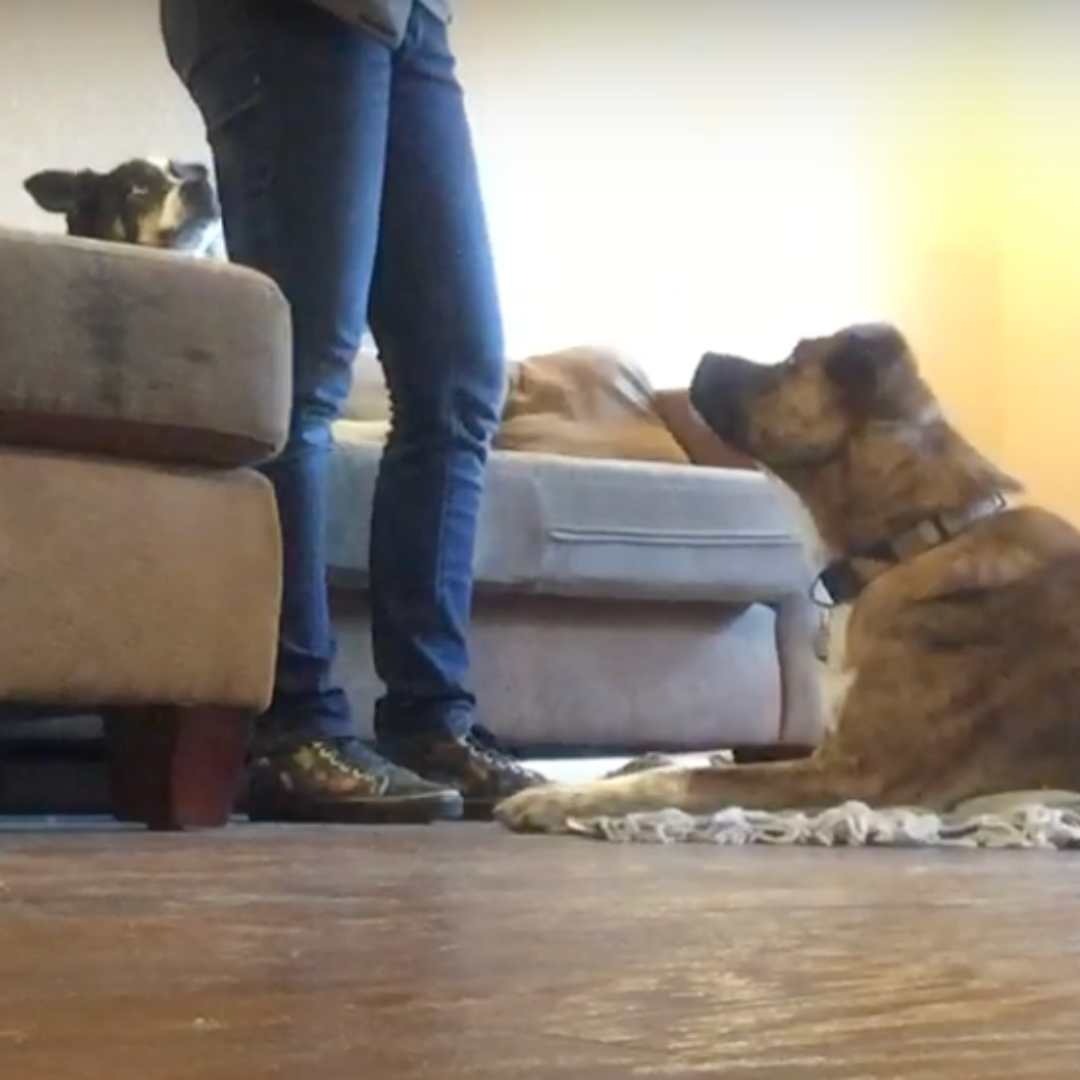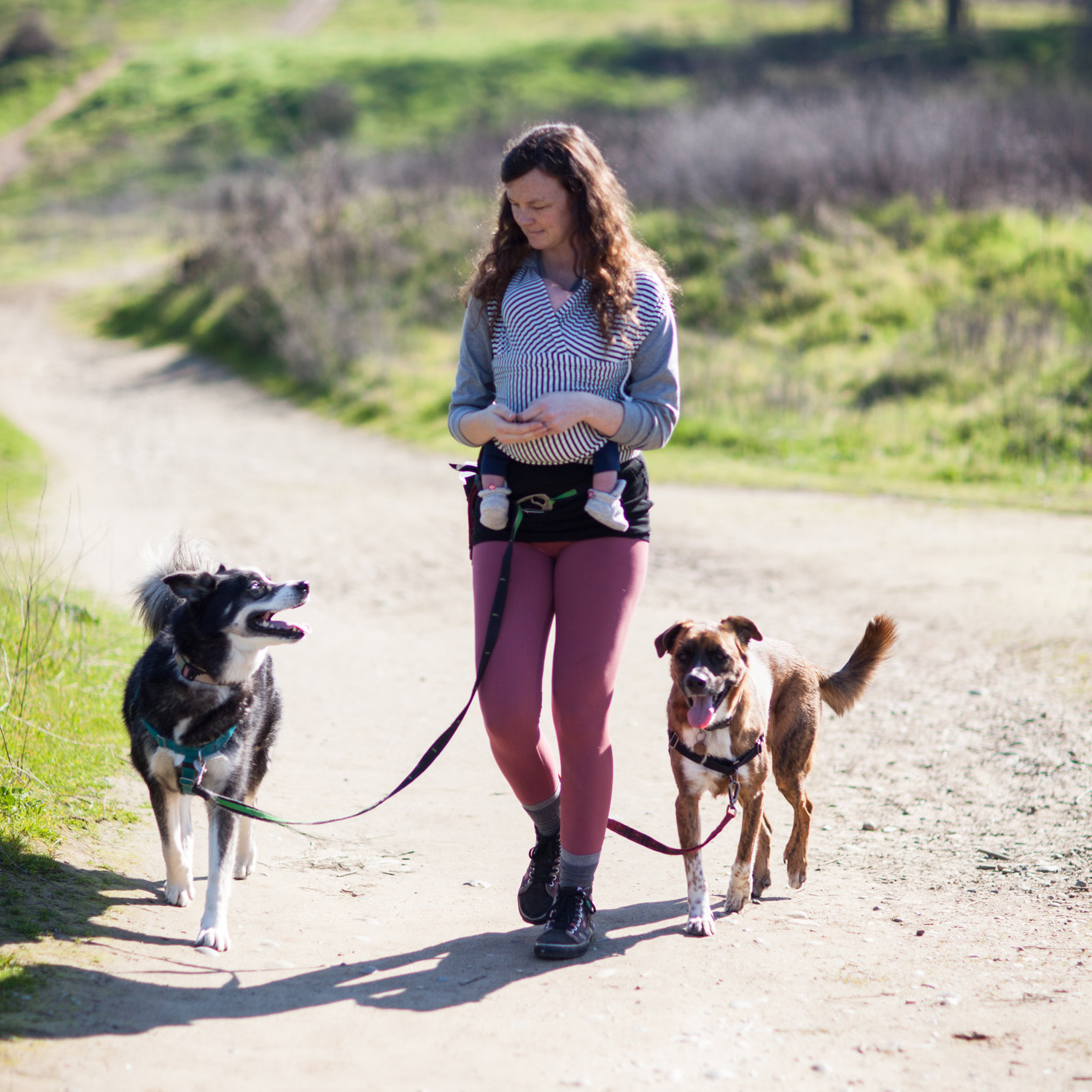Once your dog masters the basics of "go to bed," we're ready to make sure your dog understands how to maintain this new stationing skill in real-life situations - like avoiding door dashing when the doorbell rings or potential counter surfing when you're making dinner or anytime you want your dog to lie quietly and contentedly.
But before we delve into how to add distractions, distance, and duration (the "three D's") to your dog's mat training behaviors, I wanted to chat a bit about troubleshooting and common challenges as you train your dog to "go to bed."
Some of these came up in my conversation with Cory from Dogly, some from a dog mom or two, and some are just from years of teaching this skill to so many dog owners and other dogs in my life as a certified professional dog trainer. Lots of questions can pop up between the moment you start training and your release cue.
Your Dog's Plan
Stop! Don't read this long article. Instead, get everything you need to know, including all advice on Go To Mat, in a customizable step-by-step plan for your dog created by our community of certified trainers and nutritionists.
Q&A: Does my dog really understand what I'm marking, or is he just standing in front of me to get to the treats?
To teach your dog mat training skills, we are taking advantage of our dogs' natural inclination to orient to us, so at first, no, your dog probably doesn't understand exactly what we are looking for. But with repetition, you'll see the "aha moment" of understanding when your dog makes sense of of the specific cue, behavior, reward connection. Part of this comes with generalizing the behavior you're teaching your dog.
What does that actually mean?
Generalizing the mat training behavior happens with repetition and your reward timing as you teach your dog that this behavior is specific to the mat (or dog bed, area rug, or other specific place) but not specific to the room/time/place/angle where you're standing or whatever little micro things your dog may be noticing about the set-up.
Tip 1: Reset your dog in different positions using your treat rewards to get a jumpstart on generalization
Try this
Toss the treat away, but try tossing at an angle, and then slightly moving yourself around the mat. The movement pattern essentially stays the same, and you are in the same proximity to the mat, but your dog is returning at a different angle and the "picture" your dog is seeing of you standing at the mat looks a little different each time.
Give me an example
Resetting my dog with treats is what I'm doing in the video below. Ignore my periodically treating Koa on the couch - I'm just paying her for staying put until it's her turn. Welcome to real life training behaviors! (Another side note is there were a few flies in the room bugging the dogs, so when you see them freeze or flip their heads, that's what they're responding to.)
You might also notice that the surface of the floor is really slippery. I may have wanted to move to a less slick surface or try something more substantial as my "mat" if my dog was put off by the movement of the blanket beneath him. Always good to keep environmental conditions in mind in training sessions when you want to keep your dog focused on learning this and other behaviors. We never want to add distractions unintentionally while we're teaching your dog a new behavior!
Tip 2: Make sure there's a distinct texture difference from floor to mat when training
To mat train your dog successfully, going from hardwood to cloth is a more noticeable change than going from a carpet to a mat. Another way you can make this more perceptible when your dog steps on the mat is raising the mat slightly - either by folding a blanket or laying it on top of something that gives it a little lip. Of course, if you're using your dog's bed or a portable bed (super useful tool when not at your house), that's an obvious distinction.
Go To Mat
Interested in Go To Mat? Follow topics you're interested in to customize your dog’s step-by-step plan so it's most helpful and tailored to your dog when you're ready to get started.
Tip 3: Make sure your rewarding mechanics are really clean and your food isn't too visible
By clean mechanics, I mean when you mark/click/reward for the behavior, your mark/click happens first, without your hands moving to your treat bag, and then the treat delivery happens AFTER the mark.
Tell me more
As a refresher on why this is a key to success, it's all about normal human timing and how our dogs' minds work. Since most people can't be quick enough to treat the instant the desired behavior happens (which is when your dog's mind makes the connection), we use a clicker or a marker word (like yes!) to mark the exact moment and predict the rewards (high value treats) are on the way.
If the timing isn't clean, most dogs can confuse any other little thing that happens in those nanoseconds with the goal "place" behavior. This is important for ANY dog training session!
Q&A: What do I do if my dog gets stuck?
If your dog gets "stuck" at one level of the plan (for example, she's consistently getting two paws onto the mat but isn't moving up to three or four paws), there are a few things that could be at play.
Tip 4: Break steps down into even smaller increments
What does that actually mean?
If my mat training consistently focuses on marking and reinforcing my dog for touching the mat with one paw, I'm going to get a really strong "one paw on mat" behavior, but my dog will be unlikely to try variations that will lead closer to my goal point of four feet and ultimately full dog relaxed sprawl on the mat/bed.
Try this
Maybe your dog is putting two paws onto the mat but one back foot moves toward the mat slightly. Maybe two paws are on it but she's oriented further toward the front of the mat, so more of her overall body is on it. Every rep toward getting your dog to go to bed will have some natural variation. Try splitting criteria for rewards into smaller and smaller pieces so you'll be able to keep a higher rate of reinforcement that will help your dog stay motivated and engaged.
No need to wait till you get four paws onto the mat! The rate of learning tends to follow the rate of reinforcement, so try rewarding every bit of success to keep the learning pace going.
Tip 5: Getting really good at shaping means getting really good at observing
Being good at observing is about catching those subtle differences - it's a work in progress for both you and your dog!
Try this
Making a video of your session is a great way to improve your skills. I'll often catch moments in a video where I retrospectively think I should have marked and reinforced, or conversely where I could have waited a beat longer.
Tip 6: If you and your dog are getting stuck often, make it rain treats and end the session with some fun!
We all have our limits and our off days when longer periods of training only give us diminishing returns. It's always better to train more frequently for shorter periods of time and make sure teaching your dog is fun for both of you!
Then take some time to review your video (if you've recorded yourself) or brainstorm some ideas (I'm here for you!) on what you can change for the next session. We don't want to make our dogs sit through our muddling over our plan, or stressing about it not working as we'd hoped. Time with your dog should always be fun and an opportunity to bond more closely. Otherwise, time for a break - and treats!
Manners
Need more advice? Browse all guides in the Manners Channel on topics like Go To Mat, Food Manners, Party Manners, Stay, Public Manners, Travel Manners, and Basic Manners - created by our community of certified experts for you and your dog.
Q&A: When I move away from the mat, my dog orients to me and sits in front of me instead of the mat - what do I do?
This is a common impulse - your dog is learning a new cue, it looks like it's going well, we want to "test it out" and see if they're really learning what we think they're learning, or we want to take it to the next level. So we add distance or another element a bit too soon.
Tip 7: Take it slow!
Try this
Instead of jumping to adding distance, try changing the picture in more subtle ways (see Tip 1). Generally, I like to build duration before adding more distance in. It's a lot easier to teach your dog a really strong baseline behavior before adding extra challenges than jumping right to next-level training.
Are you having challenges that aren't covered here? Share any questions in the Community discussion. I'd love to help you troubleshoot!
Learn how to troubleshoot common challenges in teaching your dog to maintain his/her mat training behavior in this video.
Choose how you'd like to view this guide's video.

Next up in the Manners Channel on Dogly
Now that you and your dog have the basics of "shaping" down, you're ready to start adding duration to your "go to bed/mat" training here. This is insanely useful for real-life when you want your dog to calmly enjoy himself/herself on the mat for a long period of time.
Continue your Go To Mat training in the next guide or choose something else to train in the Manners Channel on Dogly.
And as always, I'm here to help you in the Community discussion or 1-1 if you'd rather have more personal training.

